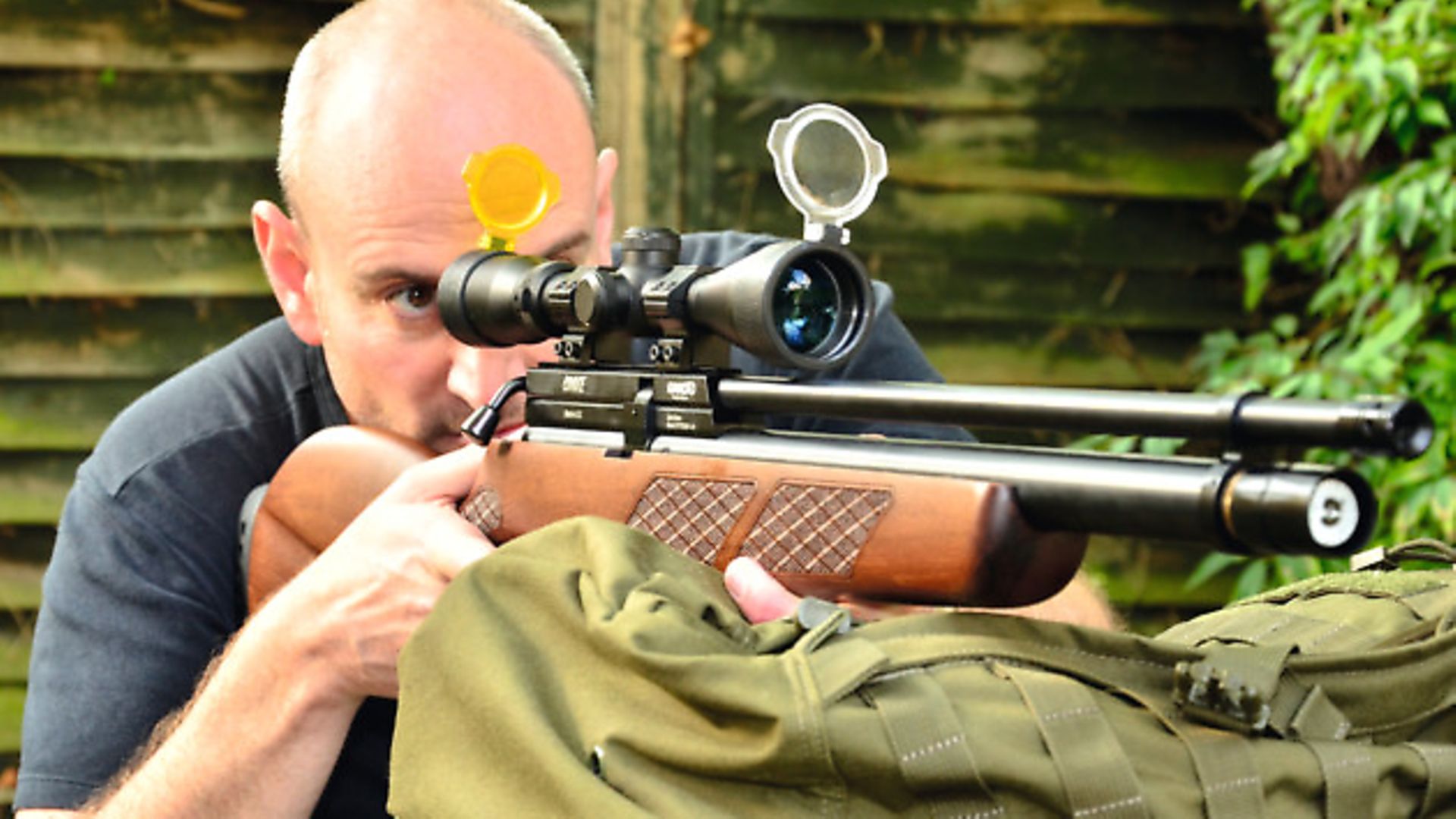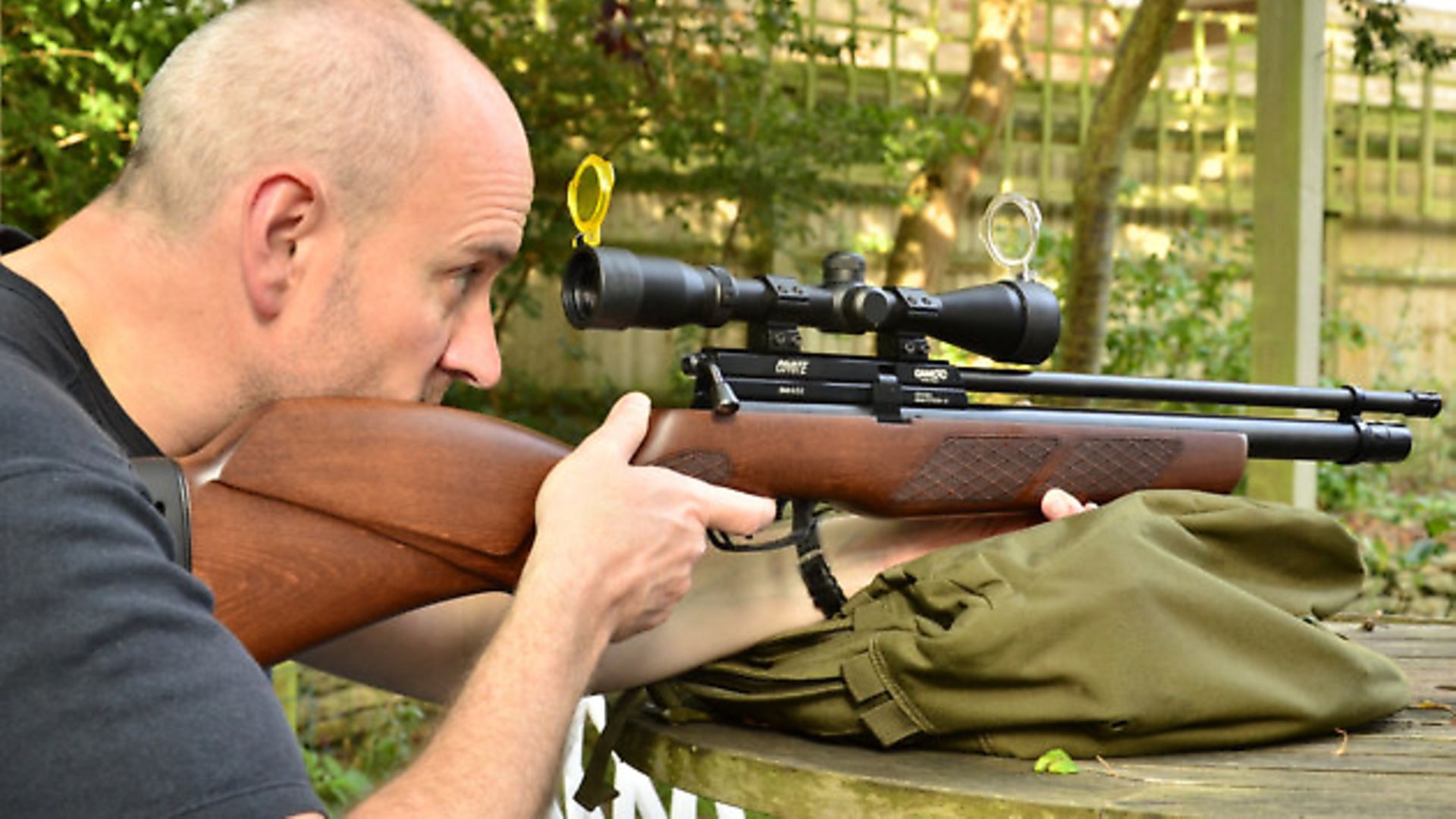The Big Test
 credit: Archant
credit: Archant
With the recession finally showing signs of being over, the airgun industry has responded in recent times by launching several new and innovative rifes. Air Arms launched two new models and there are serious rumours of another soon, Walther brought us the Rotex R8 PCP and now we have the Gamo Coyote. The last two are clearly direct competitors being similar types and having prices just £20 apart. Both are multi-shot, pre-charged pneumatics in wooden stocks, each having their own very distinctive looks. I’m also happy to report that they’re made in Europe keeping jobs and investment here. The Coyote reads ‘Made in Europe’ on the side of the breech block and as Gamo is the parent company of BSA, I’m confident that I know where this rifle was made. The quality of the machining in the breech block is very high and I also noted that the scope rails are the BSA width, rather than the narrower standard used by most manufacturers.
Euro style
If the metalwork feels English, the woodwork is definitely very European. As seems compulsory these days, the stock is ambidextrous as is the safety, with just the bolt handle remaining stubbornly right-handed. However, I’ve seen lots of lefties cycling right-handed bolts with no trouble, so I’m sure that they won’t be put off buying one of these. The cheekpiece has what I call ‘a hog’s-back look’ and some dramatic diagonal lines defining it from the rest of the stock, whilst the deep-bellied fore end has large skip-line chequering panels that match the ones on the pistol grip. The chequering is neat and well applied, having the look of being cut by a laser which I guess also cut the cute little Gamo logo in the base of the grip. At the rear, a thick, ventilated, rubber butt pad screams Gamo.
 credit: Archant
credit: Archant
This is clearly an adult-size gun with a bulk and heft that feel solid and reassuring in your hands. The dimensions are unusual with a slightly shorter than standard 14 3/8” pull length (distance from the centre of the butt bad to the centre of the trigger blade) being offset with a long reach to the trigger. On aim it feels like a long gun, whereas it is in fact slightly short. The pistol grip sweeps back in a long open arc which explains the long reach to the plastic trigger blade. Please don’t consider the trigger being plastic as any kind of cost-saving choice. In America, and some other countries, all new guns have to pass a drop test, in which they’re loaded and then dropped from a certain height onto a solid floor. To pass the test they must not fire. Setting the pull weight of the trigger really high will help, but make the rifle horrible to shoot, so the other option is to make the trigger blade as light as possible. You’ll notice from the pictures that the blade also has holes in it to lighten it further. The less mass the trigger blade has, the less likely it is to fire the rifle as it’s dropped. The polymer used is plenty stiff enough to offer a precise release, so no control is being lost. Gamo fitted their SAT2 (Smooth Action Trigger) trigger assembly which worked well, and offered a clean, predictable release straight from the box.
Directly in front of the trigger is a vertical safety tab that’s perfectly placed to be disengaged by the trigger finger just before you’re ready to fire your shot. This means it can be kept on right until the last second, maximising safety.
Layout
The rifle’s architecture is the now classic barrel-over-reservoir layout which just about everybody who is anybody uses today. It makes for a fine handling rifle with neat dimensions, explaining its near universal popularity. In an effort to keep costs down, Gamo has cleverly used the same tube that forms the air reservoir to house the hammer and valve assembly, which also adds to the clean looks. Very impressively for a rifle at this price point, there’s a pressure gauge at the front of the reservoir, something I feel every pre-charged rifle needs, yet is usually only found on more expensive models. Directly behind this is a sliding collar that protects the filling-probe aperture, which feels a bit cheap compared to the rest of the rifle. When pulled forward to expose the hole, it can come right off, so you’d need to be careful not to lose it.
Above this is a sturdy, 15.5mm thick barrel that has ‘hammer forged’ proudly stamped along it. This is yet another clue that BSA makes this rifle, because it clearly supplies the barrels. Very few companies make hammer-forged barrels and BSA is right at the top of the list, making some of the best barrels you can buy. At the muzzle it’s screw cut ½” UNF, which is the industry standard, so will accept just about any silencer you like. The Coyote is supplied with a short muzzle brake that’s more of a thread protector than a performance enhancer in my eyes. I’m sure that every hunter will fit a silencer as their first job.
10-shot mag’
The final clue about BSA’s involvement is the fact that the Coyote accepts the latest BSA 10-shot rotary magazine. This well-proven design is usually held in BSA actions with a sliding pin, adding another process to mag’ changes. On the Coyote a strong magnet pulls it in and holds it securely, which seems like a better system to me. A couple of people asked me if a magnet could offer the same precise alignment as a metal rod, which was a fair question. My answer was that I had not one problem with pellet feed throughout the test period and for me, that’s all that counts.
As mentioned, the air reservoir is filled through a probe and port set up. The Coyote has a dedicated probe which isn’t compatible with any other rifle, so be sure not to mix it up with any others in your collection. It looks similar to others, but there’s a step along the length that serves to place it at the correct depth in the port. It’s also a visual clue for us. With the rifle topped up, I chronographed it to see just how many full-power shots I’d get from the recommended 232 bar fill. To my happy surprise the .177 on test gave just over 100, at a consistent 11.3 ft.lbs. which is right as the top of the class and very impressive. The velocity was also highly consistent, varying no more than 15 fps across the whole shot string, which is again impressive. I had to make myself stop and then remember that this rifle costs less than £400, yet was performing like some top-end supergun, which cost twice as much.
Gamo describes the internals as being self-regulating and although I have no idea yet how this rifle differs from other PCPs, you have to hand it to them that they’re really on to something here.
Accuracy
The acid test of any rifle is accuracy, and all the signs were that this should be an excellent performer. Consistent velocity through a top-quality barrel is the ideal recipe. Sure enough, the accuracy was excellent. At 30 yards, shooting the Air Arms Field 8.4grain pellet, the rifle produced groups that were one enlarged hole. Even out at 50 yards on a still day, the groups were little more than an inch for the whole 10-shot magazine.
All this boosted my confidence in the Coyote and I felt sure that it would make a great hunting rifle, so I planned an afternoon walk about on a farm near home. The rabbit population is so high at the moment that they can be seen around the farm at all times of day and night. However, out for a stroll the day before, I failed to see a rut in the long grass and fell, twisting my left ankle painfully. I jumped up, embarrassed, thinking that somebody might have seen me being so clumsy when the pain really hit. Luckily for my pride, there was nobody around, so I stood still and waited for the worst of the pain to subside. By the time I got home my ankle was hugely swollen right down to my toes and going a rather nasty shade of black, blue and yellow. I could barely walk, let along hunt which was as frustrating as hell. A few days later, the Air Gunner team was due to be at the Midland Game Fair at Weston Park, so it was vital that I rested so that I’d be able to walk around the show and meet the readers. Such is life.
The only way I could enjoy the rifle before it was returned was to hobble into my back garden to do a little bit of target shooting from a rest. Our staff photographer drove over to help me out and get the pictures we needed, but I still felt horribly short-changed. Even the weather was out to get me with thunderstorms and heavy rain interrupting the photo shoot.
Despite my disappointment at not being able to use the rifle out hunting, I still really enjoyed it. It brings remarkable performance at a very low price and if I’m right about it being British made, I’m sure that the quality will be there too, to ensure a long working life as well. So if you’re thinking of moving up to PCP performance, things are getting interesting at this end of the market.